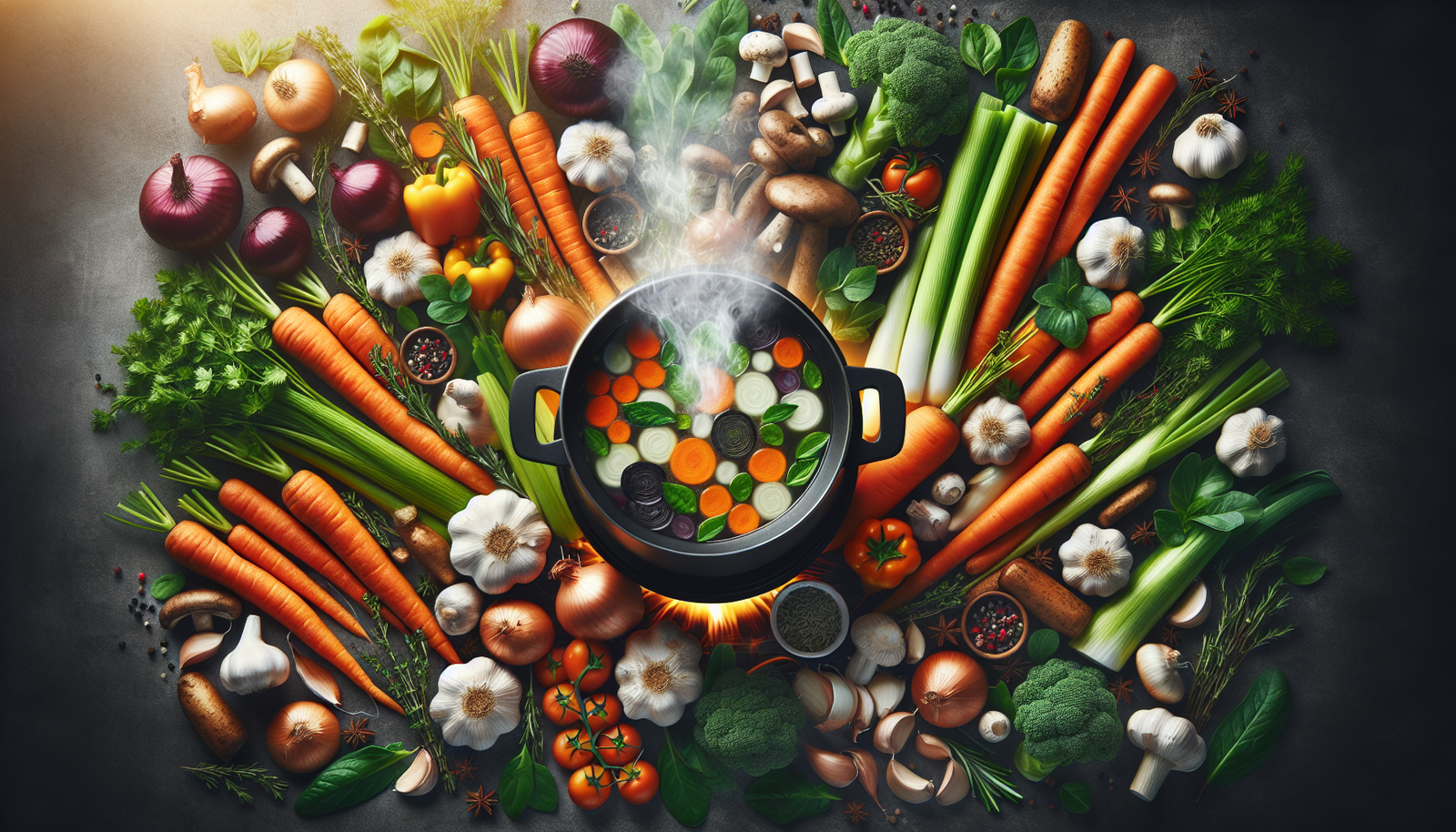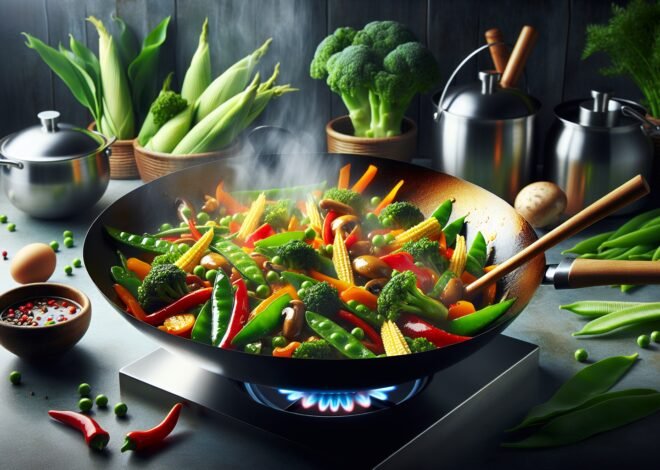
How to Make a Vegan Stock: Flavorful Alternatives to Meat-Based Stocks
Make vegan stock to create flavorful alternatives to traditional meat-based stocks. Surprisingly, the global vegan population has grown by 600% over the last three years, highlighting a shift towards plant-based diets. Crafting a delicious vegan stock is not only environmentally friendly, but it also offers a depth of flavor often unexpected in non-meat broths. This guide will delve into essential ingredients, such as vegetables and herbs, and techniques to extract maximum flavor. Whether you’re catering to dietary preferences or exploring new culinary horizons, mastering vegan stock can transform your cooking.
Understanding the Basics of Vegan Stock
Vegan stock is the backbone of countless plant-based recipes. It offers a rich profile of flavors that enhance dishes without the use of animal products. Creating a homemade vegan stock is both fulfilling and empowering, offering control over flavor and quality. Let’s delve into the fundamental aspects of vegan stock, explore its ingredients, and discover its versatile applications in the kitchen.
What is Vegan Stock and Why Use It?
Vegan stock is a flavorful liquid base made from simmering vegetables, herbs, and spices. It’s used to add depth and richness to soups, stews, risottos, and sauces. Unlike traditional meat-based stocks, vegan stock caters to plant-based diets and maintains a lighter, fresher taste.
Using vegan stock can transform ordinary recipes, boosting their taste profiles while keeping them healthy and cruelty-free. It’s perfect for those seeking to reduce their environmental impact or incorporate more plant-based meals into their diet. Vegan stock can also serve as a low-calorie alternative to enhance meals without excess fats or sodium.
Essential Ingredients for a Flavorful Vegan Stock
Creating a vegan stock that bursts with flavor requires a thoughtful selection of ingredients. Here are some essentials:
- Vegetables: Onion, carrot, and celery form the classic mirepoix base. Add leeks, garlic, or mushrooms for depth.
- Herbs: Fresh or dried herbs like thyme, parsley, and bay leaves infuse aromatic notes.
- Spices: Whole peppercorns, a pinch of salt, and other spices like cloves or star anise can add complexity.
- Umami Enhancers: Nutritional yeast, soy sauce, or miso paste boost the savory umami flavor.
Tailor your vegan stock by experimenting with different vegetable combinations and herbs. Be mindful of balancing bold flavors to avoid overpowering the stock.
Common Uses for Vegan Stock in Recipes
Vegan stock is highly versatile and can elevate various dishes. Explore its potential in the following recipes:
- Soups and Stews: Use as a base to create hearty vegetable soups or comforting stews.
- Risotto and Grains: Substitute water with vegan stock for a rich, savory flavor in risottos or quinoa.
- Sauces and Gravies: Incorporate into sauces to add depth and complexity.
- Pasta Dishes: Enhance pasta recipes by using vegan stock to create luscious sauces.
Vegan stock not only enhances taste but also improves the nutritional profile of dishes. Its versatility makes it a valuable staple in any kitchen.
Step-by-Step Guide to Making Vegan Stock
Crafting your own vegan stock is a rewarding process that ensures a richer taste and a healthier choice. This guide will walk you through the steps from preparing vegetables to storing your finished product. Embrace the art of vegan stock-making, and unlock new flavors in your culinary creations.
Preparing Vegetables for Vegan Stock
The foundation of a good vegan stock lies in the careful preparation of vegetables. Start by selecting fresh, organic vegetables to extract the best flavors. Here are the steps to prepare them:
- Wash Thoroughly: Rinse all vegetables to remove dirt and pesticides.
- Chop Evenly: Cut vegetables into uniform pieces for consistent cooking and flavor extraction.
- Retain Scraps: Use vegetable peels and trimmings like carrot tops or onion skins to reduce waste and boost flavor.
- Balance Flavors: Select a variety of vegetables to balance sweet, savory, and earthy notes.
Proper preparation ensures that your vegan stock develops a full-bodied flavor, setting the stage for a robust culinary base.
Cooking Techniques for Rich Vegan Stock
Cooking techniques greatly influence the depth and richness of your vegan stock. Follow these methods for optimal results:
- Slow Simmer: Gently simmer ingredients for 1-2 hours. This allows flavors to meld without overcooking.
- Avoid Boiling: Maintain a low temperature to prevent bitterness and cloudiness.
- Deglaze the Pot: After sautéing vegetables, use water to deglaze and capture caramelized flavors.
- Taste and Adjust: Periodically taste the stock and adjust seasoning to achieve the desired taste.
Patience is key. Slow cooking and attention to detail will reward you with a rich, aromatic stock.
Straining and Storing Your Vegan Stock
Proper straining and storage preserve the flavor and longevity of your vegan stock. Follow these steps for best results:
- Cool Before Straining: Allow the stock to cool slightly for safer handling.
- Use Fine Strainers: Employ a fine-mesh strainer or cheesecloth to remove solids and achieve clarity.
- Portion and Store: Divide stock into portions and store in airtight containers.
- Refrigerate or Freeze: Refrigerate for up to 5 days or freeze for up to 3 months.
Label containers with the date to keep track of freshness. Well-stored vegan stock is a convenient ingredient for future culinary adventures.
Enhancing Your Vegan Stock for Superior Taste
Enhancing vegan stock takes it from good to extraordinary. By infusing it with herbs, balancing flavors, and experimenting with variations, you can achieve a stock with superior taste and complexity. Let’s explore ways to elevate your vegan stock to new heights.
Adding Herbs and Spices for Depth
Herbs and spices are the secret to a rich and aromatic vegan stock. Consider the following additions:
- Herbs: Add fresh basil, rosemary, or dill for unique flavor profiles.
- Spices: Try cumin, coriander, or fennel seeds for an exotic twist.
- Aromatics: Incorporate ginger, lemongrass, or kaffir lime leaves for a fresh and vibrant note.
Use these ingredients sparingly to avoid overpowering the stock. The right blend will enhance depth and complexity.
Tips for Balancing Flavors in Vegan Stock
Achieving the right balance of flavors is crucial for a well-rounded vegan stock. Focus on these elements:
- Sweetness: Carrots and parsnips add a natural sweetness; adjust amounts as needed.
- Savoriness: Incorporate soy sauce, nutritional yeast, or tomato paste for umami richness.
- Acidity: A splash of vinegar or lemon juice can brighten and enhance flavors.
Taste frequently and adjust ingredients to achieve harmony. A balanced stock complements and enhances the dishes it accompanies.
Creative Variations and Twists on Vegan Stock Recipes
Experiment with creative variations to innovate and personalize your vegan stock:
- Roasted Vegetable Stock: Roast vegetables before simmering for a smoky depth.
- Mushroom Stock: Use various mushrooms for an earthy, umami-rich stock.
- Spicy Stock: Add chili peppers or hot sauce for a kick of heat.
These variations can serve as standalone stocks or be blended to match specific culinary needs. Enjoy the process of crafting a truly personalized vegan stock that reflects your taste and enhances your cooking.
Conclusion
Vegan stock is made by simmering vegetables and herbs in water. Common ingredients include onions, carrots, celery, garlic, and fresh herbs like thyme and parsley. It can be enhanced with spices and ingredients like nutritional yeast for depth of flavor. The mixture is cooked for about an hour, then strained to produce a clear liquid. Vegan stock is a versatile base for soups, stews, and various other dishes.
FAQ
What are the best vegetables to use for vegan stock?
The best vegetables for vegan stock include carrots, celery, onions, and garlic. These provide a rich base flavor. Leeks, mushrooms, and tomatoes can add depth, while parsnips and turnips offer a subtle sweetness. Avoid potatoes as they can cloud the stock.
How long should you simmer vegan stock for optimal flavor?
Simmer vegan stock for about 45 minutes to an hour. This time allows the vegetables to release their flavors without becoming mushy. Overcooking can lead to bitterness, so keep an eye on the clock.
Can I freeze homemade vegan stock for later use?
Yes, homemade vegan stock can be frozen. Use airtight containers or freezer bags, leaving some space for expansion. It can last up to three months in the freezer, making it a convenient option for future meals.
What herbs and spices can enhance the flavor of vegan stock?
Sage, thyme, and bay leaves work well to enhance vegan stock. Add whole peppercorns for a bit of spice. Fresh parsley or dill can introduce a refreshing note. Adjust the herbs based on your taste preferences.
How can you make a clear vegan stock without cloudiness?
Begin by avoiding starchy vegetables like potatoes. Strain the stock through a fine-mesh sieve to remove any debris. For extra clarity, use cheesecloth or a coffee filter. Skimming the top during simmering can help reduce cloudiness.
Is it possible to make a low-sodium vegan stock at home?
Absolutely! Simply replace regular salt with herbs and spices for flavor. Seaweed, such as kombu, can add a salty taste without increasing sodium levels. Taste as you go and adjust according to your dietary needs.











